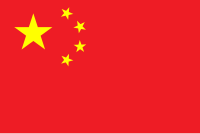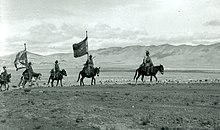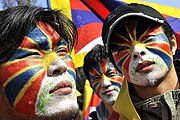Flag of Tibet
The flag of Tibet (Standard Tibetan: བོད་ཀྱི་རྒྱལ་དར།, lit. 'Tibetan national flag'), also known as the "Snow Lion flag" (gangs seng dar cha), depicts a white snow-covered mountain, a yellow sun with red and blue rays emanating from it, two Tibetan snow lions, a multi-coloured jewel representing Buddhist values, a taijitu and a yellow border around three of its four sides. The flag was used as the national flag of the independent country of Tibet from 1916 until 1951, when Tibet was annexed by the People's Republic of China.[1] It was adopted by the 13th Dalai Lama in 1916[2] and used in Tibet until the Tibetan uprising of 1959, after which the flag was outlawed in the People's Republic of China.[3] While the Tibetan flag is illegal in Tibet today as it is governed by the PRC as the Tibet Autonomous Region,[4] it continues to be used by the Central Tibetan Administration, the Tibetan government-in-exile based in Dharamshala in India,[5] and by pro-Tibet groups all over the world to show support for human rights in Tibet and Tibetan independence.[6][7]
Symbolism[edit]
 | |
| The Snow Lion Flag | |
| Use | Civil and state flag, national ensign |
|---|---|
| Proportion | 5:8 |
| Adopted | 1916 |
| Design | Two snow lions beneath a flaming blue, white and orange jewel and holding a blue and orange taijitu on a white mountain with a gold sun rising over it, all over 12 red and blue alternating rays with a gold border around the upper, lower, and hoist side of the flag. (Use by the Tibet (1912-1951) |
 | |
| Use | |
| Proportion | 5:8 |
| Design | A modernized version of the 1916 design, based off the 1947 circular emblem (Used by the Central Tibetan Administration). |
According to the Central Tibetan Administration, the Tibetan flag has the following symbolism:
- The white triangle at the center of the flag symbolises a snow-clad mountain.
- The six red stripes exist atop a blue sky representing the original ancestors of the Tibetan people: the six tribes called Se, Mu, Dong, Tong, Dru, and Ra.
- The yellow sun represents the equal enjoyment of freedom, spiritual and material happiness and prosperity by all beings in Tibet.
- The pair of snow lions represent Tibet’s victorious accomplishment of a unified spiritual and secular life.
- The three-coloured jewel held by the snow lions represent the three "supreme gems," the objects of refuge: Buddha, Dharma and Sangha.
- The two coloured swirling jewel held between the two lions represents the people’s guarding and cherishing of the self discipline of correct ethical behaviour.
- The flag’s yellow border symbolises that the teachings of the Buddha are flourishing and spreading.[5]
Flag used by the People's Republic of China[edit]


The People's Republic of China annexed Tibet in 1951, and in 1959 it outlawed the Snow Lion flag after the 1959 Tibetan uprising. The PRC has used its own national flag in the Tibet Autonomous Region. It contains a Chinese red field with five golden stars charged at the canton. The design features one large star, with four smaller stars in an arc set off towards the fly.
Design and early use[edit]

In February 1913, shortly after the fall of the Qing dynasty, the 13th Dalai Lama, Tibet's political and spiritual leader, declared independence from China and began modernising the Tibetan army.[8] According to Tsarong Dasang Dadul, the commander-in-chief of the modern Tibetan army, in 1916, a new national flag was adopted by the Dalai Lama and all army regiments were ordered to carry the flag in its present form.[9] Gyalten Namgyal, tailor to both the 13th and 14th Dalai Lamas wrote, "When I was fourteen, the Dalai Lama decided he wanted a Tibetan national flag made, and designed it himself. When a prototype was approved and the first flag commissioned, I was the one to execute the work."[10]

In addition to being carried by Tibet's army, the flag was displayed on public buildings of the Ganden Phodrang government. Historical footage shows the flag flying at the foot of the Potala Palace, the site of the Dalai Lama's government in Tibet.[11] The snow lion flag motif was also used on a flag seen by English diplomat, Sir Eric Teichman, flying above a Tibetan government building during the 1917–1918 hostilities between Sichuan and Tibet: "Over the Kalon Lama’s residence ... floats the banner of Tibet, a yellow flag bearing a device like a lion in green, with a white snow mountain and a sun and moon in the corner."[12]

Outside of Tibet, the flag was featured in publications by foreign governments, reference books, academic journals, and in culturally significant works up until 1959.[13] One of its first official international appearances was in a British Crown publication in 1923, "Drawings of the Flags in Use at the Present Time by Various Nations".[14] It was also included in the German Ministry of Defense's Naval Command, "Flaggenbuch," in 1926[15] and in the Italian Naval Ministry's "Raccolta delle Bandiere Fiamme e Insegne in uso presso le Diverse Nazioni" in 1934.[16] National Geographic Magazine featured the flag in their 1934 “Flags of the World” edition. The caption reads, "Tibet.- With its towering mountain of snow, before which stand two lions fighting for a flaming gem, the flag of Tibet is one of the most distinctive of the East."[17] Beginning in 1928, images of the flag were also widely published by companies in Europe, North America, South America, the Middle East, and Oceania in national flag collections on various forms of trading cards.[18]
The flag's first appearance at an international gathering was in March–April 1947 at the Asian Relations Conference in New Delhi.[19] The Conference, organised by Pandit Jawaharlal Nehru, hosted Asian states and anti-colonial movements. The representative of the British government of India in Lhasa, Hugh Richardson, personally shared the invitation from the Indian Council of World Affairs with the Tibetan Foreign Office and advised that the conference was a good opportunity to show Asia and the world that Tibet was de facto an independent country.[20] At the conference, leaders of each of the thirty-two delegations sat on a dais behind a plate with the name and flag of their country.[21] American historian A. Tom Grunfeld asserts that the conference was not government-sponsored, and so Tibet's and the Tibetan flag's presence had "no diplomatic significance", adding that the flag was removed after representatives from the Republic of China protested to conference organisers who then issued a statement that Jawaharlal Nehru had invited the Tibetan delegates "in a personal capacity".[22][23] A Tibetan delegate who attended the conference claims that this did not occur and the only existing photos from the conference show the flag displayed along with other participating countries' flags.[24]

After the People’s Liberation Army invaded Tibet and the 17-Point Agreement was signed, the flag continued to be used in the 1950s under the Chinese government, although the flag's status was unclear. Many in the Chinese Communist Party felt that the usage of the flag indicated separatism, but the Tibetan local government at the time stressed that the flag was an army flag (the Tibetan army continued to exist parallel to People's Liberation Army infantries) and not a national flag. Phuntso Wangye claims that Mao Zedong discussed the flag in 1955 conversation with the 14th Dalai Lama. According to the story, Mao told the Dalai Lama that Zhang Jingwu, Zhang Guohua, and Fan Ming told him that Tibet had a "national flag". The Dalai Lama replied that Tibet had an army flag. Reportedly, Mao replied that "you may keep your national flag". There is no official recognition of this conversation by the Chinese government however.[3]
During this period before 1959, the flag continued to be recognised internationally as a national flag in reference books and by foreign governments. When the Dalai Lama visited the Himalayan kingdom of Sikkim in 1956 the Tibetan flag was used by the Sikkimese government to welcome him. The flag can be seen in historic footage flying on the same flagpole alongside the flag of Sikkim at the Chogyal’s Tsuklakhang Palace and on the Dalai Lama’s motorcade provided by the royal family.[25]
American anthropologist Melvyn Goldstein argues that while the Tibetan flag was used by the army, few Tibetans in Tibet knew about it so when they wanted to protest against the Chinese government, they would use the flag of Chushi Gangdruk instead.[26] Tibetan historian, Jamyang Norbu, has challenged this assertion citing incidents of the Tibetan public’s regard for the flag as their national symbol.[27]
Pro-independence symbol[edit]
After the 1959 Tibetan Uprising, the 14th Dalai Lama left his position as Ruler of Tibet, denounced the 17-Point Agreement with the PRC, and established the exile Central Tibetan Administration in India. As part of his project to inculcate pan-Tibetan nationalism (of all Tibetan people and not just those in his previous domain of the Tibet Autonomous Region), he standardised and adopted symbols as nationalist symbols, such as the Lhasa dialect of Tibetan, a Tibetan national anthem, and the flag.[28] The flag is popularly known as the Snow Lion flag due to the presence of the two snow lions.[29] The flag was adopted as a symbol of the Tibetan independence movement, and has become known as the "Free Tibet flag".[30][31] Through the diaspora's and international protesters' use of the flag, it became known and used in protest by the Tibetan public.[28] The flag is banned in mainland China.[29][30]
-
Hsiao Bi-khim, a Taiwanese politician from the DPP, wears a shirt featuring the Tibetan flag at a Free Tibet demonstration in 2008.
-
Tibetan flags painted on the faces of Tibetan demonstrators
-
Duke University student Grace Wang Qianyuan during her speech on Free Tibet in 2008.
-
A Tibetan flag at the Cracovia Marathon, 2013
Flag emoji[edit]
The flag of Tibet does not have its own emoji.[32] Tibetan activists unsuccessfully petitioned the Unicode Consortium for a Tibet flag emoji in 2019.[33] Wired noted that Taiwan, where China's sovereignty is also challenged, has an emoji for its flag.[33] However, Wired also noted that a Tibetan flag emoji may open a Pandora's box of similar requests from other unrecognised states and independence movements.[33]
Controversy[edit]

In 2012, Tibetan Prime Minister Lobsang Sangay was photographed with the flag of Tibet in Ladakh, India, prompting the Chinese government to issue a statement criticising the public display of the flag. The Indian government had previously promised the Chinese government that it would not allow anti-China political activities by Tibetan exiles on Indian territory.[34]
See also[edit]
References[edit]
- ^ Goldstein, Melvyn C. (2009). A History of Modern Tibet: The Calm Before the Storm: 1951–1955. Vol. 2. University of California Press. p. 302. ISBN 978-0-520-25995-9.
- ^ Dundul Namgyal Tsarong (10 October 2000). In the Service of His Country: The Biography Of Dasang Damdul Tsarong Commander General Of Tibet. Shambhala. p. 51. ISBN 978-1-55939-981-4.
- ^ a b Melvyn C. Goldstein, Dawei Sherap, and William R. Siebenschuh, A Tibetan revolutionary : the political life and times of Bapa Phuntso Wangye, University of California Press, 2004, pp. 174–175, 194–195
- ^ Freedom House. "Freedom in the World 2020: Tibet". Retrieved 9 May 2021.
- ^ a b Administration, Central Tibetan. "The Tibetan National Flag". Retrieved 25 August 2016.
- ^ "The Tibetan flag". Free Tibet. Retrieved 11 March 2024.
- ^ Haas, Benjamin; correspondent, Benjamin Haas China (26 November 2017). "China under-20 football tour suspended after pro-Tibet protests". The Guardian. ISSN 0261-3077. Retrieved 11 March 2024.
- ^ Sheel, R. N. Rahul. "The Institution of the Dalai Lama". The Tibet Journal, Vol. XIV No. 3. Autumn 1989, pp. 20.
- ^ Tsarong, p. 51.
- ^ Johnson, Sandy (1996). "Palace Intrigues". Written at New York. The Book of Tibetan elders : Life Stories and Wisdom from the Great Spiritual Masters of Tibet. New York, NY: Riverhead Books. p. 66. ISBN 9781573226073. OCLC 34191822.
When I was fourteen, the Dalai Lama decided he wanted a Tibetan national flag made, and designed it himself. When a prototype was approved and the first flag commissioned, I was the one to execute the work.
- ^ Cruickshank, Dan (Director) (15 November 2006). The Lost World of Tibet (Motion picture). Tibet: British Broadcasting Corporation (BBC), Cruickshank. Event occurs at 38:16.
- ^ Teichman, Eric, Sir (1922). Travels of a consular officer in Eastern Tibet. London: Cambridge University Press. p. 116. Retrieved 23 March 2015.
{{cite book}}: CS1 maint: multiple names: authors list (link) - ^ Gulotta, Nick (8 March 2021). "Recognizing the Snow Lion: New Examples of International Awareness of Tibet's National Flag". Retrieved 10 March 2021.
- ^ Admiralty, Authority (1923). Drawings of the Flags in Use at the Present Time by Various Nations. London: His Majesty’s Stationery Office. p. 66.
- ^ Marineleitung, Germany (1926). Flaggenbuch. Berlin: Druck und Verlag der Reichsdruckerei.
- ^ Direzione Generale Armi e Armamenti Navali, Ministero della marina (1934). Raccolta delle Bandiere Fiamme e Insegne in uso presso le Diverse Nazioni. Rome: Ministero della Marina. p. 82.
- ^ Grosvenor, Gilbert; Showalter, William J. (September 1934). "Flags of the World". The National Geographic Magazine. LXVI – No. 3. Washington, D.C.: National Geographic Society.
- ^ Gulotta, Nick; Yangzom, Dicky. "Tibet on the Cards of History: Revisiting the Tibetan National Flag". Archived from the original on 1 April 2019. Retrieved 23 March 2015.
- ^ Central Tibetan Administration. "CTA's Response to Chinese Government Allegations: Part Four". Tibet.net. Central Tibetan Administration. Retrieved 10 March 2021.
- ^ Claude Arpi, Tibet, le pays sacrifié, Bouquineo, 2011, p. 225: "À la fin de 1946, la rumeur circula à Lhassa qu’une délégation du gouvernement tibétain allait être invitée en Inde pour participer à une conférence panasiatique. Le représentant britannique à Lhassa, Hugh Richardson, transmit l’invitation officielle du Conseil indien pour les Affaires mondiales au gouvernement [tibétain]." (The British representative in Lhasa, Hugh Richardson, conveyed the Indian Council of World Affairs' official invitation to the [Tibetan] government).
- ^ Arpi, Claude. "Fifty Years Ago: The Asian Relations Conference". Phayul. Phayul.com. Archived from the original on 1 April 2019. Retrieved 21 October 2016.
- ^ Grunfeld, A. Tom (1996). The Making of Modern Tibet. p. 78.
- ^ Garver, John W. (2001). Protracted Contest: Sino-Indian Rivalry in the Twentieth Century. University of Washington Press. p. 44.
- ^ Sampho, Tenzin Thondup (1987). The Violent Waves of My Life (In Tibetan) metse balap trukpo. Dehradun: self-published..
- ^ Gulotta, Nick (8 March 2021). "Recognizing the Snow Lion: New Examples of International Awareness of Tibet's National Flag". tibetanreview.net. The Tibetan Review. Retrieved 10 March 2021.
- ^ Goldstein, Melvyn C.; Jiao, Ben; Tanzen Lhundrup (2009). On the Cultural Revolution in Tibet: The Nyemo Incident of 1969. University of California Press. p. 209.
- ^ Norbu, Jamyang (12 February 2015). "Freedom Wind, Freedom Song". jamyangnorbu.com. Shadow Tibet. Retrieved 10 March 2021.
- ^ a b French, Patrick (2009). Tibet, Tibet. Random House. pp. 24, 230.
- ^ a b Lama Jabb (10 June 2015). Oral and Literary Continuities in Modern Tibetan Literature: The Inescapable Nation. Lexington Books. p. 35. ISBN 9781498503341.
Employing symbols that reinforce Tibetan national identity, he begins by invoking the banned Tibetan national flag.
- ^ a b BBC News: 'Free Tibet' flags made in China, 28 April 2008
- ^ Nugent, Helen (1 February 2009). "Five pro-Tibet demonstrators arrested in clash outside Chinese embassy". The Sunday Times. Retrieved 16 January 2011.
- ^ "Tibetan Flag Emoji". Tibetan Flag Emoji. Retrieved 19 April 2021.
- ^ a b c Pardes, Arielle (25 October 2019). "In Flying Flags, Emoji Become Political". Wired. ISSN 1059-1028. Retrieved 31 May 2021.
- ^ Dasgupta, Saibal (10 July 2017). "Unfurling Of Tibetan Flag On The Shores Of Ladakh's Pangong Lake Riles Up Protests In China". India Times. Archived from the original on 25 November 2017. Retrieved 3 December 2017.
Chinese media is criticizing a reported move by the Tibetan government in exile to unfurl a flag representing its idea of "Tibetan national flag" on the shores of Bangong Lake, known as Pangong Lake in India, in Ladakh.
External links[edit]
- Flag of Tibet at Flags of the World
- "The Tibetan National Flag". Historical Background. Central Tibetan Administration. Retrieved 30 May 2020.
- "Tibet flag page". Flags: Past and Present. Roberto Breschi. Retrieved 30 May 2020.



![Duke University student Grace Wang Qianyuan [fr] during her speech on Free Tibet in 2008.](http://upload.wikimedia.org/wikipedia/commons/thumb/4/4c/2008_Duke_University_Student_Grace_Wang_Qianyuan_Explains_Idea_of_Free_Tibet_in_Public_%E7%BE%8E%E5%9C%8B%E6%9D%9C%E5%85%8B%E5%A4%A7%E5%AD%B8%E5%A5%B3%E5%AD%B8%E7%94%9F%E7%8E%8B%E5%8D%83%E6%BA%90%E5%9C%A8%E8%A5%BF%E8%97%8F-%E5%9C%96%E5%8D%9A%E9%9B%AA%E5%B1%B1%E7%8D%85%E5%AD%90%E6%97%97%E8%88%87%E5%85%AC%E7%9C%BE%E5%89%8D%E9%97%A1%E9%87%8B%E8%87%AA%E7%94%B1%E8%A5%BF%E8%97%8F-%E5%9C%96%E5%8D%9A%E7%90%86%E5%BF%B5.jpg/101px-thumbnail.jpg)
